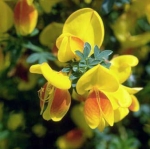| Common Name: |
Scotch Broom |
| Other Names: |
Broom |
| Botanical Name: |
Cytisus scoparius syn Sarothamnus scoparius |
| Genus: |
Cytisus |
| Family: |
Papilionaceae |
| Native Location: |
W Europe |
| Cultivation: |
Well-drained soil in sun or partial shade. Cut back shoots by two-thirds after flowering. Cytisus does not transplant well. Subject to statuatory control as a weed in some countries, notably in parts of Australia. |
| Propagation: |
By seed sown in spring or autumn; by ripewood cuttings in midsummer; by semi-ripe cuttings in late summer. Germination is erratic. |
| Harvest: |
Tops of shoots are cut as flowering begins and dried for use in decoctions, infusions, liquid extracts, and tinctures; stocks are renewed annually. |
| Height: |
1.5-2m (5-6ft) |
| Width: |
1.5-2m (5-6ft) |
| Variations: |
f. andreanus
Has bicolored red and yellow flowers.
Subsp. maritimus syn. var. prostratus
Is low-growing with arching, overlapping stems and gray-green foliage.
Height: 20cm (8in)
Width: 1.5m (5ft) |
| Hardiness: |
Z5-8 |
| Parts Used: |
Whole plant, Leaves |
| Properties: |
A bitter, narcotic herb that depresses respiration, regulates heart action, and had diuretic and purgative effects. |
| Chemical Constituents: |
Cytisine
Genisteine
Hydroxytyramine
Sarothammine
Scoparin
Sparteine
|
| Known Effects: |
Stimulates uterine contractions
Helps body dispose of excess fluid by increasing amount of urine produced
Sometimes causes sharp rise in blood pressure
|
| Possible Additional Effects: |
May treat congestive heart failure
May produce sedative-hypnotic effect when smoked
|
| Medicinal Uses: |
Internally, mainly for heart complaints, especially with Convallaria majalis (See, lily of the valley) in heart failure. Excess causes respiratory collapse. Not given to pregnant women or patients with high blood pressure. For use by qualified practioners only. |
| Warnings and Precautions: |
Toxic if Eaten
This herb is subject to legal restrictions n some countries.
Don't take if you:
Are pregnant, think you may be pregnant or plan pregnancy in the near furture
Have any chronic disease of the gastrointestinal tract, such as stomach or duodenal ulcers, reflux esophagitis, ulcerative colitis, spastic colitis, diverticulosis, or diverticulitis
Consult your doctor if you:
Take this herb for any medical problem that doesn't improve in 2 weeks (There may be safer, more effective treatments.)
Take any medicinal drugs or herbs including aspirin, laxatives, cold and cough remedies, antacids, vitamins, minerals, amino acids, supplements, other prescription or non-prescription drugs
Pregnancy:
Don't use unless prescribed by your doctor
Breastfeeding:
Don't use unless prescribed by your doctor.
Infants and Children:
Treating infants and children under 2 with any herbal preparation is hazardous.
Others:
None are expected, if you are beyond childhood, under 45, not pregnant, basically healthy, take it only for a short time and do not exceed manufacturer's recommended dose.
Storage:
Store in cool, dry area away from direct light, but don't freeze.
Store safely out of reach of children.
Don't store in bathroom medicine cabinet. Heat and moisture may change the action of the herb.
Safe Dosage:
Consult your doctor for the appropriate dose for your condition.
|
| Toxicity: |
Rated slightly dangerous, particularly in children, persons over 55 and those who take larger that appropriate quantities for extended periods of time. |
| Adverse Reactions, Side Effects, or Overdose Symptoms: |
| Signs and Symptoms: |
What to do: |
|
| Diarrhea |
Discontinue. Call doctor immediately. |
| Nausea or Vomiting |
Discontinue. Call doctor immediately. |
|
| Bibliography: |
Encyclopedia of Herbs by Deni Brown Copyright © 1995, 2001 Dorling Kindersley Limited Pp 189-190
Vitamins, Herbs, Minerals & Supplements The Complete Guide. by H. Winter Griffith, MD Copyright©1998 Fisher Books pp. 434-435 |
